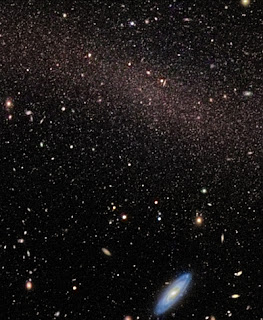Hierarchical Galaxy formation on small scales
An investigation by:
- David Martínez-Delgado (Max-Planck Institut für Astronomie)
- Aaron Romanowsky (University of California)
- R. Jay GaBany (Blackbird Observatories)
- Francesca Annibali (Osservatorio Astronomico di Bologna)
- Jacob A. Arnold (University of California)
- Juergen Fliri (Paris Observatory-GEPI)
- Stefano Zibetti (Dark Cosmology Centre Niels Bohr Institute)
- Roeland P. van der Marel (Space Telescope Science Institute)
- Hans-Walter Rix (Max-Planck-Institut fur Astronomy)
- Taylor S. Chonis (University of Texas)
- Julio A. Carballo-Bello (Instituto de Astrofisica de Canarias)
- Andrea V. Maccio (Max-Planck-Institut fur Astronomy)
- Alessandra Aloisi (Osservatorio Astronomico di Bologna)
- Jordi Gallego (Fosca Nit Observatory)
- Jean P. Brodie (University of California)
- Michael R. Merrifield (University of Nottingham)
Abstract:
We have mapped and analyzed a stellar stream in the halo of the nearby dwarf starburst galaxy NGC 4449, detecting it in deep integrated-light images using the Black Bird II Observatory 0.5 meter telescope, and resolving it into a river of individual red giant branch stars using the 8.2 meter Subaru/Suprime-Cam (NAOJ).
The properties of the stream imply a massive dwarf spheroidal progenitor, which will continue to disrupt and deposit an amount of stellar mass that is comparable to the existing stellar halo of the main galaxy. The ratio between luminosity or stellar-mass between the two galaxies is near 1:50, while the dynamical mass-ratio when including dark matter may be between 1:10 and 1:5. This system thus represent a "stealth" merger, where an infalling satellite galaxy is nearly undetectable by conventional means, yet has a substantial dynamical influence on its host galaxy.This singular discovery also suggests that satellite accretion can play a significant role in building up the stellar halos of low-mass galaxies, and possibly in triggering their starbursts.
A paper describing the research work has been submitted and accepted for publication at Astronomy & Astrophysics journal.
Documentation in PDF format is available for download in the Articles section.The images on the right
Top image, which was used in preliminary research work, is a deep widefield (1.69 "/pixel scale) LRGB image taken in 2010 with TOA-150 telescope and STL-11000M camera (with an accumulated exposure of 3 hours) from Fosca Nit Observatory. Complete exposure details and a full resolution version can be seen in Gallery section.
Second image is an inverted luminance version of previous image, more clearly showing tidal stream. These images were acquired with CCDCommander (CCDSoft, The Sky & FocusMax) and entirely processed with PixInsight.
Third image which has been the base of the scientific work, is a very deep and detailed image (0.46 "/pixel scale) of NGC4449 and tidal stream, taken by R. Jay Gabany with Ritchey-Chretien 0.5 meter f/8.3 telescope and U16M CCD camera at Blackbird Observatories. This extremely high quality image gives a lot of galaxy detail and clearly shows tidal stream.Image is copyright © by R. Jay Gabany and is shown here by permission from the author. Complete exposure details and a higher resolution version is available in author's website.
Bottom image is a close up view (0.202 "/pixel scale) of image taken by 8.2 meter Subaru telescope (NAOJ) which resolves the stream into its constituent stars. Complete information on this superb image, that includes color data acquired from Blackbird Observatories and that has been entirely processed by R. Jay Gabany, is available in author's website.
Original December 2011 publication can be found here (old blog, scroll down the page).




No comments:
Post a Comment